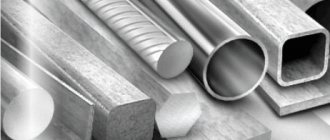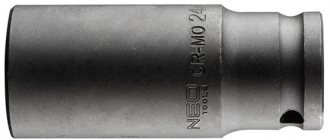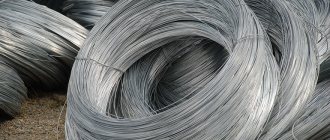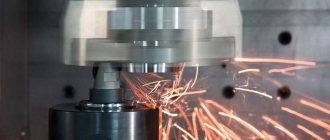AISI 304 steel has an almost full-fledged analogue - alloy grade 12Х18Н10Т. However, some differences in the chemical composition of these alloys make it possible to compare them and find the difference between aisi 304 and 12x18n10t in the properties when using them. So, when choosing steel for the manufacture of a certain type of structure or part, you must be guided by this data.
Chemical composition that allows you to determine the difference between aisi 304 and 12x18n10t
Nickel. AISI 304 – up to 10-11%. 12Х18Н10Т - similar
Chromium. AISI 304 - up to 20%. 12Х18Н10Т — 17-19%
Copper. AISI 304 – up to 0.3%. 12Х18Н10Т - similar
Carbon – AISI 304 – up to 0.08%. 12Х18Н10Т – up to 0.12%
Titanium - AISI 304 - no more than 0.3%. 12Х18Н10Т – 0.8%.
For the complete chemical composition of these alloys, see table.
| Stamps | C | Mn | P | S | Si | Cr | Ni | Ti | Fe |
| 12Х18Н10Т | <0,12 | <2,0 | <0,035 | <0,02 | <0,8 | 17,0-19,0 | 9,0-11,0 | <0,4-1 | Rest |
| AISI 304 | <0,08 | <2,0 | <0,045 | <0,03 | <1,0 | 18,0-20,0 | 8,0-10,5 | — | Rest |
Table of Russian and foreign analogues of stainless steel AISI 304, 316, 430, 12x18n10t
APEX METAL offers customers a variety of types of stainless steel products made from the best grades of stainless steel that meet strict international standards and have excellent technological and performance characteristics.
High corrosion resistance of stainless steel is the main characteristic of products made from these materials for long-term operation in aggressive corrosive environments, over wide temperature ranges. The chemical composition of rolled products made of corrosion-resistant stainless steel AISI 304 of the austenitic class meets the requirements of the AISI standard - American Iron and Steell Institute (American Institute of Steel and Alloys). In accompanying documents, the designation of AISI stainless steel grades and its analogues is made in accordance with national or international standards:
| National standard | Stainless steel grade | |||
| AISI USA | steel AISI 304 | steel AISI 321 | steel AISI 316 | steel AISI 430 |
| RF standard | 08Х18Н10 | 12Х18Н10Т | 08Х17Н13М2 | 12Х17 |
| EN Europe | 1.4301 | 1.4541 | 1.4436 | 1.4016 |
| UNS USA | S30400 | S32100 | S31600 | S43000 |
| SIS Sweden | 2332/33 | 2337 | 2343 | 2320 |
| BS UK | 304S31 | 321S31 | 316S33 | 430S17 |
| JIS Japan | SUS304 | SUS321 | SUS316 | SUS430 |
| DIN Germany | X5CrNi18-10 | X10CrNiTi18-10 | X3CrNiMo18-3-4 | X6Cr17 |
Stainless steel 12x18n10t and analogue AISI 304 12x18n10t - comparison of steels.
AISI 304 steel has an almost full-fledged analogue - alloy grade 12Х18Н10Т. However, some differences in the chemical composition of these alloys make it possible to compare them and find the difference between aisi 304 and 12x18n10t in the properties when using them. So, when choosing steel for the manufacture of a certain type of structure or part, you must be guided by this data.
Perm, Kultaevo
stainless steel welding
Chemical composition that allows you to determine the difference between aisi 304 and 12x18n10t
Nickel. AISI 304 – up to 10-11%. 12Х18Н10Т – similar
Chromium. AISI 304 – up to 20%. 12Х18Н10Т – 17-19%
Copper. AISI 304 – up to 0.3%. 12Х18Н10Т – similar
Carbon – AISI 304 – up to 0.08%. 12Х18Н10Т – up to 0.12%
Titanium – AISI 304 – no more than 0.3%. 12Х18Н10Т – 0.8%.
What information can be found by the designation of stainless steel grades
The stainless properties of steel are due to the presence of alloying elements in its composition, the main of which are chromium and nickel. To impart special properties (greater strength, cold resistance, etc.) and improve technological characteristics, other alloying elements (for example, titanium, molybdenum, manganese), and nanoadditives of rare earth metals are added to steel.
Thanks to titanium alloying, stainless steel 12x18n10t acquires increased cold resistance and is used for the manufacture of welded products for cryogenic equipment operating at temperatures down to -269˚C. In addition, by the symbol of steel grades you can determine:
- The chemical composition of steel, for example, chromium stainless steel X6Cr17 - aisi 430 contains up to 0.08% mass fraction of carbon (the number 6 after the letter X indicates the average carbon content in steel, multiplied by 100) and 16 - 18% chromium
- Steel class, for example, the number 3 in the designation of AISI 316 stainless steel indicates that it belongs to the austenitic class. Accordingly, the number 4 in the designation of steel 430 indicates that the steel belongs to the ferritic class, the next two digits determine the serial number of the steel in the group
- The European standard indicates that stainless steel belongs to a certain type; by the serial numbers of steels 1.4301, 1.4436, 1.4016, it can be determined that the grades in question belong to the group of stainless steels (this group includes steels numbered 1.40ХХ-1.45ХХ)
- The letter S in the designation of steel according to the UNS standard indicates that the material belongs to the group of heat-resistant and corrosion-resistant (stainless) steels (this group includes steels designated S00001...S99999)
- In the designation of steel according to the Swedish standard, the numbers 23ХХ indicate the chromium content in the steel (all grades discussed in the table belong to the group of steels with a chromium content ≥10%)
- In the standards in force in the Russian Federation, by
the symbol of steel one can judge its elemental composition; regulatory documents for stainless steel (GOST 5632 and others) provide information on the classification of steel, chemical composition, properties, purpose and areas of application - In the designation of steel according to the Swedish standard, the numbers 23XX indicate chromium ≥10%)
- In the standards in force on the territory of the Russian Federation, by the symbol of steel one can judge its elemental
Price list for all types of stainless steel sheets (mirror, matte, polished, corrugated): AISI 304/ 08x18n10, AISI 321/ 12x18n10t, AISI 430/ 12x17.
Prices for stainless steel tape 12x18n10t for the nuclear, chemical, food industry, furniture industry, mechanical engineering.
Source
GOST and other regulatory documents for steel
Stainless steel 12Х18Н10Т is manufactured in accordance with GOST requirements:
- 1133-71 - by forging round and square sections;
- 18143-72 - wire;
- 18907-73 - rods;
- 25054-81 - forgings, supplied in annealed condition;
- 4986-79 — cold-rolled strip;
- 9940-81 - seamless hot-rolled pipes;
- 9941-81 - seamless rolled pipes in cold and warm condition;
- 2879-2006 - hot-rolled hexagon.
In addition to the above, a number of standards are used for the manufacture of high-precision profiles, as well as products and parts made of corrosion-resistant heat-resistant steel.
Mechanical properties of 12Х18Н10Т
| Section, mm | Section, mm | B, MPa | 0.2, MPa | 5, % | , % |
| Rods. Quenching 1020-1100 °C, air, oil or water. | 60 | 510 | 196 | 40 | 55 |
| The rods are ground and processed to a specified strength. | 590-830 | 20 | |||
| Hard-worked rods. | 4 | 530 | 236 | 38 | |
| Stainless steel sheets, hot-rolled or cold-rolled. Quenching 1050-1080°C, water or air. |
Technological properties of 12Х18Н10Т
Forging temperature
The initial temperature during hot processing should be about +1200 °C, and upon completion it drops to +850 °C. If the cross-section of stainless steel sheets does not exceed 350 mm, then cooling is carried out in air.
Flock sensitivity
Machinability
In the hardened state at HB 169 and B = 610 MPa: Ku tv. spl. = 0.85, Ku b. Art. = 0.35.
Weldability
Stainless steel has excellent weldability, so welding can be carried out without any special restrictions. After welding, it is recommended to perform heat treatment.
Stainless steel concept
Let's give a definition: stainless steel is a complex alloy steel that is resistant to rust in atmospheric conditions and corrosion in aggressive environments.1
Its resistance to corrosion differs from conventional carbon steels and therefore is widely used in the food industry, oil and gas and chemical industries for operation with highly aggressive environments and food products, since during storage, oxides and other substances do not form upon contact of the liquid and the surface of the container, which may affect the properties of the stored product.
What is stainless steel from a chemical point of view? — This is an alloy with a minimum mass fraction of chromium of 10.5% and a maximum mass fraction of carbon of 1.2%.2
In simple terms, stainless steel is made by adding alloying substances to iron in different proportions to obtain the required characteristics.
Thus, the main alloying element is chromium Cr. The alloys also additionally contain carbon C, nickel Ni, silicon Si, manganese Mn, titanium Ti, niobium Nb, cobalt Co, molybdenum Mo, vanadium V, sulfur S, phosphorus P, tungsten W, aluminum Al, copper Cu, cobalt Co.
Stainless steel 12Х18Н10Т
Substitutes
Substitute - steels 08Х18Г8Н2Т, 10Х14Г14Н4Т, 12Х17Г9А4, 08Х22Н6Т, 08Х17Т, 15Х25Т, 12Х18Н9Т.
Foreign analogues
| Germany DIN | Brand | X10CrNiTi18-9 |
| Number | 1.4541 | |
| USA (AISI, SAE, ASTM) | 321 | |
| France (AFNOR) | Z10CN18 | |
| UK (BS) | 320S31 | |
| Sweden (SS) | 2337 | |
| Italy UNI | — | |
| Japan | SUS321 | |
IMPORTANT. The possibility of replacement is determined in each specific case after assessing and comparing the properties of steels
Interpretation of steel 12Х18Н10Т
The number 12 indicates the average carbon content in hundredths of a percent, i.e. for steel 12Х18Н10Т this value is 0.12%.
The letter “X” indicates the chromium content of the steel. The number 18 after the letter “X” indicates the approximate amount of chromium in steel as a percentage, rounded to the nearest whole number, i.e. chromium content about 18%.
The letter “N” indicates the nickel content of the steel. The number 10 after the letter “N” indicates the approximate amount of nickel in steel as a percentage, rounded to the nearest whole number, i.e. Nickel content is about 10%.
The letter "T" indicates the titanium content of the steel. The titanium content in steel does not exceed 1.5%.
Type of delivery
Long products, including shaped steel: GOST 5949-75, GOST 2590-88, GOST 2879-88. Calibrated rod GOST 7417-75, GOST 8559-75, GOST 8560-78. Polished rod and silver steel GOST 14955-77, GOST 18907-73. Thick sheet GOST 7350-77. Thin sheet GOST 5582-75. Tape GOST 4986-79. Wire GOST 18143-72. Forgings and forged blanks GOST 25054-81, GOST 1133-71. Pipes GOST 9940-72, GOST 9941-72, GOST 14162-79.
Weldability
Steel 12Х18Н10Т is weldable without restrictions. Welding methods: RDS, ESW and KTS (Contact Spot Welding). Subsequent heat treatment is recommended.
Technological properties
Forging temperature, °C: beginning 1200, end 850. Sections up to 350 mm are cooled in air. Cutting machinability - Kv tv.spl = 0.85 and Kv b.st = 0.35 in the hardened state at HB 169 and σw = 610 MPa. Flock sensitivity - not sensitive.
Chemical composition, % (GOST 5632-2014)
| Steel | C | Si | Mn | Cr | Ni | Ti | S | P |
| 12Х18Н10Т | no more than 0.12 | no more than 0.80 | no more than 2.00 | 17,0-19,0 | 9,0-11,0 | 5,0-8,0 | no more than 0.02 | no more than 0.40 |
Application of 12Х18Н10Т
Purpose - parts operating up to 600 °C; welded machines and vessels operating in dilute solutions of nitric, acetic, phosphoric acids, solutions of alkalis and salts and other parts operating under pressure at temperatures from -196 to +600 °C, and in the presence of aggressive media - up to +350 °C.
Corrosion-resistant (stainless) steel is of the austenitic class and is mainly used as corrosion-resistant, but can also be used as heat-resistant and heat-resistant. In terms of heat resistance, it is close to steel 12Х18Н9Т.
It is used for the manufacture of welded equipment in various industries.
Approximate application as heat-resistant steel
Purpose: pipes, furnace fittings, heat exchangers, muffles, retorts, exhaust pipes and manifolds, spark plug electrodes. Recommended maximum temperature for long-term use (up to 10,000 hours), 800°C.
The temperature at which intense scale formation begins in air is 850°C.
Unstable in sulfur-containing environments. They are used in cases where nickel-free steels cannot be used.
Approximate application as heat-resistant steel
Exhaust system parts, pipes, sheet and section parts.
Recommended maximum application temperature is 600°C.
Service life - Very long.
The temperature at which intense scale formation begins in air is 850°C.
Application of steel 12Х18Н10Т for bodies, covers, flanges, membranes and valve assembly made from rolled products, forgings (stampings) (GOST 33260-2015)
| steel grade | ND for supply | Temperature of the working medium (wall), °C | Additional instructions for use |
| 12Х18Н10Т GOST 5632 | Long products GOST 5949. Sheets GOST 7350. Forgings GOST 25054. Pipes GOST 9940, GOST 9941 (made of 12Х18Н10Т) | -270 to 350 | For welded fittings operating in aggressive environments: HNO3, alkalis, ammonium nitrate, food media, special equipment media, ship fittings, cryogenic media, hydrogen sulfide-containing media; for membranes |
| St. 350 to 610 | For welded reinforcement assemblies in the absence of a requirement for resistance to intergranular corrosion |
Application of steel 12Х18Н10Т for fittings fasteners (GOST 33260-2015)
| Steel grade, according to GOST 1759.0 | Material standard or specification | Application options | |||||
| Bolts, studs, screws | Nuts | Flat washers | |||||
| Ambient temperature, °C | Nominal pressure Pn, MPa (kgf/cm2) | Ambient temperature, °C | Nominal pressure Pn, MPa (kgf/cm2) | Ambient temperature, °C | Nominal pressure Pn, MPa (kgf/cm2) | ||
| 12Х18Н10Т | GOST 5632 | -196 to 600 | Not regulated | -196 to 600 | Not regulated | -196 to 600 | Not regulated |
The use of steel 12Х18Н10Т for the manufacture of spindles and rods (GOST 33260-2015)
| steel grade | ND for supply | Working environment temperature, °C | Additional instructions for use |
| 12Х18Н10Т GOST 5632 | Long products GOST 5949 | -270 to 350 | It is used for work in aggressive environments: nitric acid, alkalis, ammonium nitrate, food environments, environments of special equipment, shipbuilding, cryogenic equipment and hydrogen sulfide-containing environments. Used for welded joints |
| Long products GOST 5949 | St. 350 to 610 | Suitable for use in environments that do not cause intergranular corrosion |
Application of steel 12Х18Н10Т for bellows (GOST 33260-2015)
| steel grade | ND for supply | RD for the production of bellows | Working environment temperature, °C | Operating pressure Pp, MPa (kgf/cm2), no more | Additional instructions for use |
| 12Х18Н10Т GOST 5632 | Sheet GOST 5582. Tape GOST 4986, (for steel 1.4541) | GOST 21744, GOST 22388 | -260 to 550 | From 0.6 to 25.0 (from 6 to 250) | For water, steam, inert gases and cryogenic temperatures. For mildly aggressive environments - up to a temperature of 350°C. For corrosive environments - up to 150°C |
| Pipe GOST 10498 | -260 to 465 | From 0.15 to 3.10 (from 1.5 to 31.0) |
NOTE The table shows the limit values for temperatures and operating pressures. Specific combinations of application parameters (working pressure, axial stroke, temperature and full assigned life) are given in the regulatory documentation for bellows.
Application of steel 12Х18Н10Т for valve valve assembly
| steel grade | Working environment temperature, °C | Hardness | Additional instructions for use |
| 12Х18Н10Т GOST 5632 | -100 to 300 | 155…170 HB | The functionality of the valve assembly is ensured by the presence of surfacing or other wear-resistant coating in the mating part |
Application of steel 12Х18Н10Т for helical coil springs
| steel grade | ND for supply | Application temperature, °C | Additional instructions for use |
| 12Х18Н10Т GOST 5632 | Wire | -253 to 400 | Safety, control valves, low-magnetic springs |
Application of steel 12Х18Н10Т for gaskets
| steel grade | Type of semi-finished product | Application temperature, °C | Additional instructions for use | |
| Name | ND for supply | |||
| 12Х18Н10Т GOST 5632 | Thick heat-treated sheets | GOST 7350 | -253 to 600 | Suitable for use in corrosive environments |
Resistance of steel 12Х18Н10Т to sulfide corrosion cracking
| Method of forming blanks | Name of parts |
| Forgings, stampings, rolled products | Body, bonnet, stem, spindle, valve seal parts, bellows end parts |
Maximum permissible temperature for the use of steel 12Х18Н10Т in environments containing ammonia
| steel grade | Temperature of application of steels, °C at partial pressure of ammonia, MPa (kgf/cm) | ||
| St. 1(10) to 2(20) | St. 2(20) to 5(50) | St. 5(50) to 8(80) | |
| 12Х18Н10Т | 540 | 540 | 540 |
Maximum permissible temperature for the use of steel 12Х18Н10Т in hydrogen-containing environments
| steel grade | Temperature, °C, at partial pressure of hydrogen, PH2, MPa (kgf/cm2) | ||||||
| 1,5(15) | 2,5(25) | 5(50) | 10(100) | 20(200) | 30(300) | 40(400) | |
| 12Х18Н10Т | 510 | 510 | 510 | 510 | 510 | 510 | 510 |
- The parameters for using steels indicated in the table also apply to welded joints.
- The partial pressure of hydrogen is calculated by the formula: PH2 = (C*Pp)/100, where C is the percentage in the system; PH2—hydrogen partial pressure; Pp is the operating pressure in the system.
Relative erosion resistance coefficient of reinforcement parts made of steel 12Х18Н10Т
| Details of the flow part of the fittings | Part material | Erosion resistance coefficient relative to steel 12X18H10T | Maximum pressure drop at which there is no erosive wear, MPa |
| Body, pipes, rod, plunger (gate), seat | 12Х18Н10Т | 1,0 | 4,0 |
- The coefficient of erosion resistance of a material is the ratio of the rate of erosive wear of the material to the rate of erosive wear of steel 12Х18Н10Т (taken as 1).
- Materials are erosion-resistant if the coefficient of relative erosion resistance Kn is at least 0.5 and the hardness of the material is HRC≥28.
Resistance of steel 12Х18Н10Т against crevice erosion
Resistance of steel 12Х18Н10Т against impact erosion
| Toughness Point | NV no more | Materials |
| 5 | 150 | Austenitic chromium-nickel stainless steel grade 12Х18Н10Т |
Application of steel 12Х18Н10Т for the manufacture of main parts of nuclear power plant fittings
| steel grade | Type of semi-finished product or product | Maximum permissible temperature of use, °C |
| 12Х18Н10Т GOST 5632, GOST 24030 | Sheets, pipes, forgings, long products. Fasteners | 600 |
Characteristics
Density ρ at test temperature, 20 °C - 7900 kg/cm3
Thermal conductivity coefficient λ W/(m*K) at test temperature, °C
Electrical resistivity ρ, nOhm*m, at test temperature °C —
Specific heat capacity c, J/(kg*K), at test temperature, °C
Thermal conductivity coefficient λ, W/(m*K), at test temperature, °C
Linear expansion coefficient α*106, K-1, at test temperature, °C
Modulus of normal elasticity E, GPa, at test temperature °C
The full chemical composition of 12Х18Н10Т and AISI 304 is in the table.
| Stamps | C | Mn | P | S | Si | Cr | Ni | Ti | Fe |
| 12Х18Н10Т | <0,12 | <2,0 | <0,035 | <0,02 | <0,8 | 17,0-19,0 | 9,0-11,0 | <0,4-1 | Rest |
| AISI 304 | <0,08 | <2,0 | <0,045 | <0,03 | <1,0 | 18,0-20,0 | 8,0-10,5 | – | Rest |











